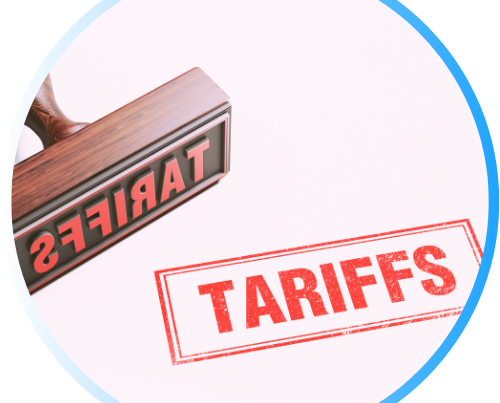Rate Related Update and Market Conditions
Market Conditions
TPEB (Trans-Pacific Eastbound)
-
Booking activity for July and August is softer this year as many shippers advanced their volumes to beat anticipated tariffs. While overall demand remains steady, it’s being shaped by unique strategies and cargo profiles. Spot rates on both coasts are nearing fixed levels, with East Coast surcharges still slightly higher than the West. The June 15 PSS has largely been withdrawn across all gateways.
FEWB (Far East Westbound)
-
Shippers are seeing rising rates and tighter space as carriers roll out July GRIs—some reaching $4,300 per FEU. Demand is building toward a July peak, fueled by constrained space and equipment shortages. Geopolitical concerns around the Middle East are prompting modest fuel-related surcharge risks, though most FEWB carriers continue to avoid the Red Sea and route via the Cape of Good Hope.
TAWB (Trans-Atlantic Westbound)
-
The trade lane continues to face a mix of labor and infrastructure-related challenges. Strike action in Belgium and construction in Hamburg are slowing inland and port operations, with ripple effects across key gateways like Rotterdam, Piraeus, and Genoa. Most carriers are holding off on new PSS until July, with only minor surcharges under discussion for West Med lanes.
Operational Updates
TPEB:
-
Equipment remains adequately available at origin ports throughout Asia. No widespread container or chassis shortages are reported at this time.
FEWB:
-
Return sailings are increasingly delayed due to ongoing congestion at European hubs, particularly Antwerp. Inland transport in Germany is strained by barge and rail delays, with container backlogs also building due to low Rhine River water levels.
TAWB:
-
Chassis and container shortages persist across Central and Eastern Europe. Portuguese ports and Southern Turkey are also facing equipment constraints, which may impact scheduling and lead times.
Capacity Management
TPEB:
-
Carrier capacity is being cautiously reduced as of July, though not enough to significantly tighten supply yet. Offered space dipped 4% below normal this week after exceeding norms last week. Blank sailings appear to have leveled out after weeks of decline.
FEWB:
-
Early July blank sailings—especially on key alliance routes—are shrinking capacity and leading to elevated rollover rates. This trend may intensify as peak season demand builds and port congestion continues.
TAWB:
-
While European port delays continue, overall vessel capacity is not yet being aggressively withdrawn. Carriers appear to be managing disruptions through selective service changes and adjusted inland routing.
Sources: xeneta.com, maersk.com, yangming.com, evergreen-line.com, supplychaindive.com
📌 Current U.S. Tariff Status (as of June 27, 2025)
- Aluminum Imports Face 200% Tariff Without Origin Details: Effective June 28, aluminum shipments lacking a declared country of smelt and cast must be filed as Russian origin and will be subject to a 200% Section 232 duty. Importers are also required to apply Russia’s Chapter 99 HTS code when submitting entries.
- Steel Appliance Tariffs Expand: As of June 23, new Section 232 rules apply a 50% tariff to steel-based consumer goods, including washing machines, refrigerators, and dishwashers. The duty is assessed based on the value of steel within each product.
- China Reciprocal Tariff Timeline: Chinese-origin goods entered on or after May 14 remain under a 10% reciprocal tariff until August 11. If the U.S.-China trade agreement takes effect, the tariff stays at 10%, contributing to a total 55% effective duty. Without a deal, the rate will revert to 34%.
- Reciprocal Tariff Pause Nears Expiration: The 90-day pause on country-specific reciprocal tariffs is set to end July 9. While an extension is likely, it has not been officially confirmed by the administration.
Source: whitehouse.gov, politico.com, whitehouse.gov


Trans‑Pacific volume dips as Asia–Europe peak season heats up
Trans‑Pacific trade is set to experience a slowdown in volume and rates as frontloaded shipments diminish, while Asia‑Europe sees a stronger outlook. Spot rates have surged—Asia‑Europe recently reached $2,842 per FEU, a 49% increase since May 31—reflecting robust demand and anticipated peak‑season activity.
EU and U.S. aim for trade deal ahead of July tariff deadline
U.S. and EU officials are optimistic about reaching an agreement before the July 9 deadline, which would prevent a 50% U.S. tariff on most EU goods. Leaders noted improved momentum in recent talks, balancing negotiation with contingency planning. The EU has also prepared retaliatory tariffs on select U.S. products in case a deal isn’t reached in time.


WTO: Global Trade Sees Early 2025 Surge as Importers Rush to Beat Tariffs
Global goods trade grew in early 2025, with the WTO reporting a rise in its barometer index to 103.5—the highest since August 2021. The increase was driven by a spike in imports as businesses accelerated orders ahead of anticipated U.S. tariff hikes. While export orders declined, gains were seen in container volumes, air freight, autos, and electronics. The WTO notes trade may slow later this year as inventory levels are drawn down.

